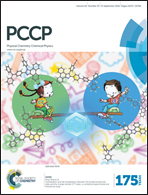High-performance colossal permittivity materials of (Nb + Er) co-doped TiO2 for large capacitors and high-energy-density storage devices†
Abstract
The search for colossal permittivity (CP) materials is imperative because of their potential for promising applications in the areas of device miniaturization and energy storage. High-performance CP materials require high dielectric permittivity, low dielectric loss and relatively weak dependence of frequency- and temperature. In this work, we first investigate the CP behavior of rutile TiO2 ceramics co-doped with niobium and erbium, i.e., (Er0.5Nb0.5)xTi1−xO2. Excellent dielectric properties were observed in the materials, including a CP of up to 104–105 and a low dielectric loss (tan δ) down to 0.03, which are lower than that of the previously reported co-doped TiO2 CP materials when measured at 1 kHz. Stabilities of frequency and temperature were also accomplished via doping Er and Nb. Valence states of the elements in the material were analyzed using X-ray photoelectron spectroscopy. The Er induced secondary phases were observed using elemental mapping and energy-dispersive spectrometry. Consequently, this work may provide comprehensive guidance to develop high-performance CP materials for fully solid-state capacitor and energy storage applications.


 Please wait while we load your content...
Please wait while we load your content...